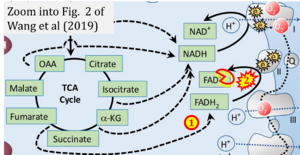Wang 2019 Trends Biochem Sci
| Wang K, Jiang J, Lei Y, Zhou S, Wei Y, Huang C (2019) Targeting metabolic-redox circuits for cancer therapy. Trends Biochem Sci 44:401-14. https://doi.org/10.1016/j.tibs.2019.01.001 |
Wang K, Jiang J, Lei Y, Zhou S, Wei Y, Huang C (2019) Trends Biochem Sci
Abstract: Metabolic alterations and elevated levels of reactive oxygen species (ROS) are two characteristics of cancer. The metabolic patterns of cancer cells are elaborately reprogrammed to fulfill the high biomass demands of rapid propagation. ROS, the byproducts of metabolic processes, are accumulated in cancer cells partially due to metabolic abnormalities or oncogenic mutations. To prevent oxidative damage, cancer cells can orchestrate metabolic adaptation to maintain reduction-oxidation (redox) balance by producing reducing equivalents. ROS, acting as second messengers, can in turn manipulate metabolic pathways by directly or indirectly affecting the function of metabolic enzymes. In this review we discuss how cancer cell metabolism and redox signaling are intertwined, with an emphasis on the perspective of targeting metabolic-redox circuits for cancer therapy.
• Bioblast editor: Gnaiger E
Correction: FADH2 and Complex II
- FADH2 is shown as the substrate feeding electrons into Complex II (CII). This is wrong and requires correction - for details see Gnaiger (2024).
- Gnaiger E (2024) Complex II ambiguities ― FADH2 in the electron transfer system. J Biol Chem 300:105470. https://doi.org/10.1016/j.jbc.2023.105470 - »Bioblast link«
Labels: Pathology: Cancer
Enzyme: Complex II;succinate dehydrogenase


